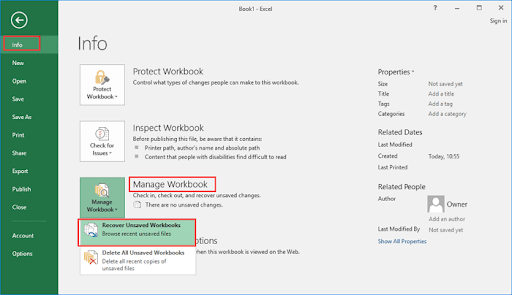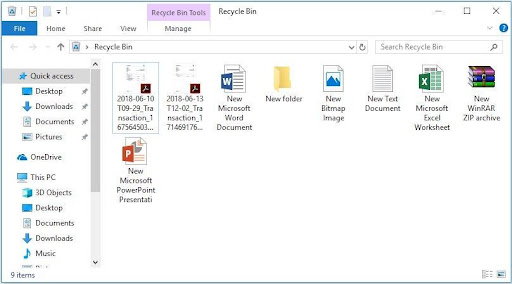Succeed is a program that allows customers to create and edit worksheets that can perform a variety of skills such as drafting and performing tests. While working with an Excel-like program, it may be common for clients to complete records that they may need to access by mistake. Thus, you may benefit from setting up a system to retrieve deleted records in Excel if you unexpectedly delete a report that you really need to see or edit.
In this article, we will look at some of the reasons why a person might need to work out a specific way to recover a deleted Excel record and research a summary of its steps.
Why might you sometimes need to recover a deleted worksheet in Excel?
There can be many basics as to why a person might need to get a worksheet deleted from Excel. For example, perhaps the most remarkable reason for hoping to return a report is to a place where the client accidentally tapes the Delete button or moves an unacceptable record in the Trash envelope while trying to erase the replacement archive. Someone similarly may need to replace a deleted worksheet in the event of his Excel system crashing, to gain unsaved work that is obviously lost. Basically, it may be helpful to know how to restore these records in case your PC gear breaks or your web usage misses the mark.
The best strategy for recovering deleted worksheets in Excel
The following are a few steps you can follow to recover a deleted worksheet from Excel:
Really check your Trash Coordinator
Before embarking on a well-known method of retrieving a deleted record in Excel, it may always be necessary to check your PC’s Trash Envelope first. This is due to the fact that many records are moved to the Trash link when you delete them, and if you have not cleaned your Trash envelope recently, there may be an open door for your archive to be present. To check your trash envelope, you can scroll through your PC’s main menu or menu bar at the bottom of your screen and look for a “Squander” stamped envelope or picture container.
After you open the link, you can look at the records that tend to select whether your Excel worksheet exists. By accepting that you find it in your trash, you can simply move the record from the Trash envelope to your workplace or to data recovery software.
Open the Information file tab
If you do not find your deleted worksheet in your Trash envelope, you can start the report process by opening Excel and browsing the file menu. In the File menu, you can tap the Information tab to appear in another options menu. The file menu always appears at the top of the screen, but depending on the Excel version and type of PC you are using, it may appear as a button in the upper left corner of the Excel application window. In the current case, the button remains green in various forms.

Find the Manage Changes tab
When you appear on the File menu info tab, the corresponding section is to find a tab called Manage Changes. This will then check you for a summary of the records with the different types of records you create each time you click “save” in the report. Once you find the Changes management tab, you can tap on it to open another order menu.
Scroll to the Find Unsaved Workbooks tab
Within the Manage Changes window, one of the available recordings is probably checking “Restore Unsaved Workbooks.” This is an application you can use to review unsaved reports that you may have deleted and the different variations you receive when there are many. In the event that you receive this request, you can tap on it to open a window that presents the archives recover shift deleted excel file.
Find the record name and variation of the worksheet you want to return
When you open the Restore Unsaved Workbooks menu, it shows a comprehensive view of records that you may have previously created but have not been saved. The next step is to look at these record names in the workbook you really want to restore. Success often displays these reports by requesting a sequence according to the date and time you make it, so you can start looking at the main area in the proposed topic and accept at least for now that you are trying to restore the record you were in.
Once you find the manual of the work you are trying to restore, you can tap on it to check the various properties open.
Related: Advanced Excel Skills: Definitions and Examples

Return the desired change
In the event that you find the record you are looking for, you can see the variation in the report you are looking for. There may be several types of each record you open, especially if you change it frequently. While retrieving an accidentally deleted record, it may be difficult to select the most recent version of the archive so you can access the translation with the most relevant information and edit. At the point where you find a variation of the worksheet you really want to restore, you can tap on it to install it.
Then, in the meantime, you can tap the yellow bar button that provides the “Restore” checker to restore the record.
Strategies to prevent accidental completion of the worksheet
The following are a few references that you can refer to save your work:
Turn on auto-save
A few Excel versions offer a section called Auto Save. The Automatic Backup feature allows the system to save each time a client stops performing without requiring the client to click the Save button. This can minimize the potential consequences of record loss, as it maintains a distinct diversity of each report gradually as clients work through it.
Create support records
Another way to keep yourself from completing your job is to create support records. Perhaps the most inexpensive way to do this is simply to maintain two variations on each record when working on it. You can do this by keeping the work manual in the normal way, and then duplicating the record to create two closed, unspecified properties.
Protect your reports in an anonymous way
You can similarly protect your reports by adding a privacy statement to all of them. For example, many people use unaffected programs to add compatible settings to Excel reports that require a password to open, edit and delete each record. This can be a real achievement considering the fact that whether you are the one who came to the report or not, giving a secret name before you take action could allow you to disclose what you are doing and do without breaking any records unexpectedly. .
Note that none of the organizations mentioned in this article actually cooperate with it.